- Home
- Garden Wildlife
- Insects
- Lepidoptera
- Moths solitary caterpillars
Moths with solitary larvae
Most moths lay their eggs in batches on suitable food plants for their caterpillar larvae, but after hatching, the larvae disperse and lead solitary lives. The relatively small number of species where the larvae stick together are covered in our page on moths with gregarious larvae.
The great majority of moth caterpillars do not live in groups, but are solitary, so in a sense this page covers nearly all moths. Some moth families have rather distinctive and easily spotted caterpillars, most are much less prominent and cryptic. We cover moths with leaf-mining caterpillars, stem-boring caterpillars, and root-feeding caterpillars on separate pages.
Geometridae
The family of geometrid moths derives its name from "earth-measurers", because the caterpillars also known as "inchworms" move relatively rapidly with a looping movement
White plume moth Pterophorus pentadactyla Carnation tortrix moth Cacoecimorpha pronubana
Role of moths with solitary larvae in gardens
Most moth larvae are inconspicuous and cause no significant damage to garden plants. Some moths have larvae that will attract attention to themselves because they can damage the foliage of garden plants. These include cabbage moth, Mamestra brassicae, on brassicas and other plants; winter moth, Operophtera brumata, on fruit trees and other deciduous trees; angleshades moth, Phlogophora meticulosa, on many plants; lesser yellow underwing, Noctua comes, on many low-growing plants; mullein moth, Shargacucullia verbasci, on verbascum species; carnation tortrix moth, Cacoecimorpha pronubana, on many garden and glasshouse plants; tomato moth, also known as bright-line brown-eye, Lacanobia oleracea, on tomato.
Moth larvae are an extremely important food source for many garden birds which collect them in huge numbers to feed their hatchlings.
References
1. Shinji Sugiura, Kazuo Yamazaki 2014 Caterpillar hair as a physical barrier against invertebrate predators, Behavioral Ecology, Volume 25, Pages 975–983, https://doi.org/10.1093/beheco/aru080
2. Stireman, J.O., and M.S. Singer. 2003. Determinants of parasitoid-host associations: insights from a natural tachinid-lepidopteran community. Ecology 84(2): 296-310.
Books
James, D.G. (2017) The Book of Caterpillars. Ivy Press (Not for identification use! International in scope, but a fascinating and well illustrated compendium of caterpillar diversity)
Porter, J. (2010) Colour Identification Guide to the Caterpillars of the British Isles. Apollo Books
Sterling, P., Henwood, B., Lewington, R. (2020) Field Guide to the Caterpillars of Great Britain and Ireland
Bloomsbury Wildlife Guides
Websites
Website of UK Moths
Page drafted by Andrew Halstead, reviewed by Andrew Salisbury, edited by Steve Head
Geometrid caterpillars have unique features making them easy to identify. They have only two or three pairs of prolegs at the rear of their body, instead of the five pairs found in most lepidoptera, and the prolegs and true legs are separated by a long body - necessary for their looping locomotion. Many larvae are cryptically coloured, and when at rest they sometimes hold on with their prolegs and hold the long thin body out at an angle mimicking a twig. Another trick when threatened is to drop off the plant, remaining attached by a single silk thread spun from an organ below their mouth. Hanging in mid air, they are almost invulnerable to bird predators, and climb back up the thread when the panic is over.
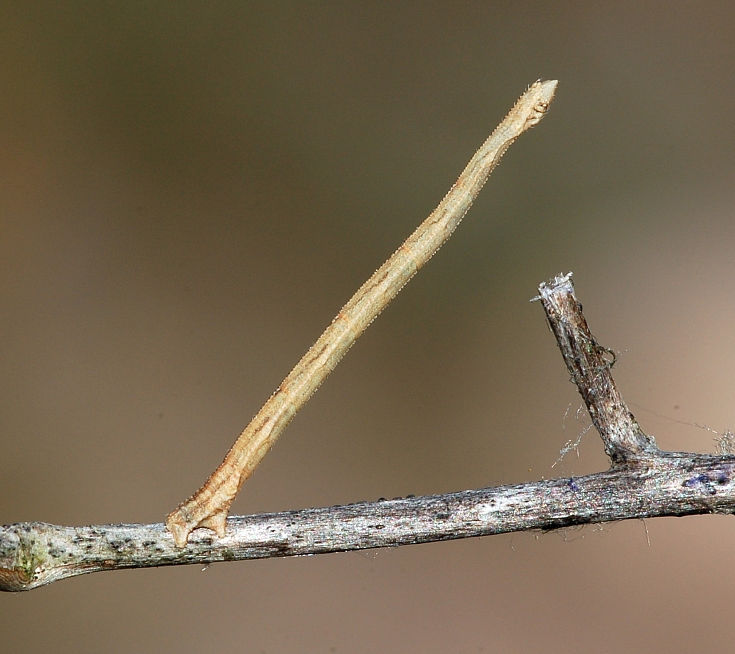
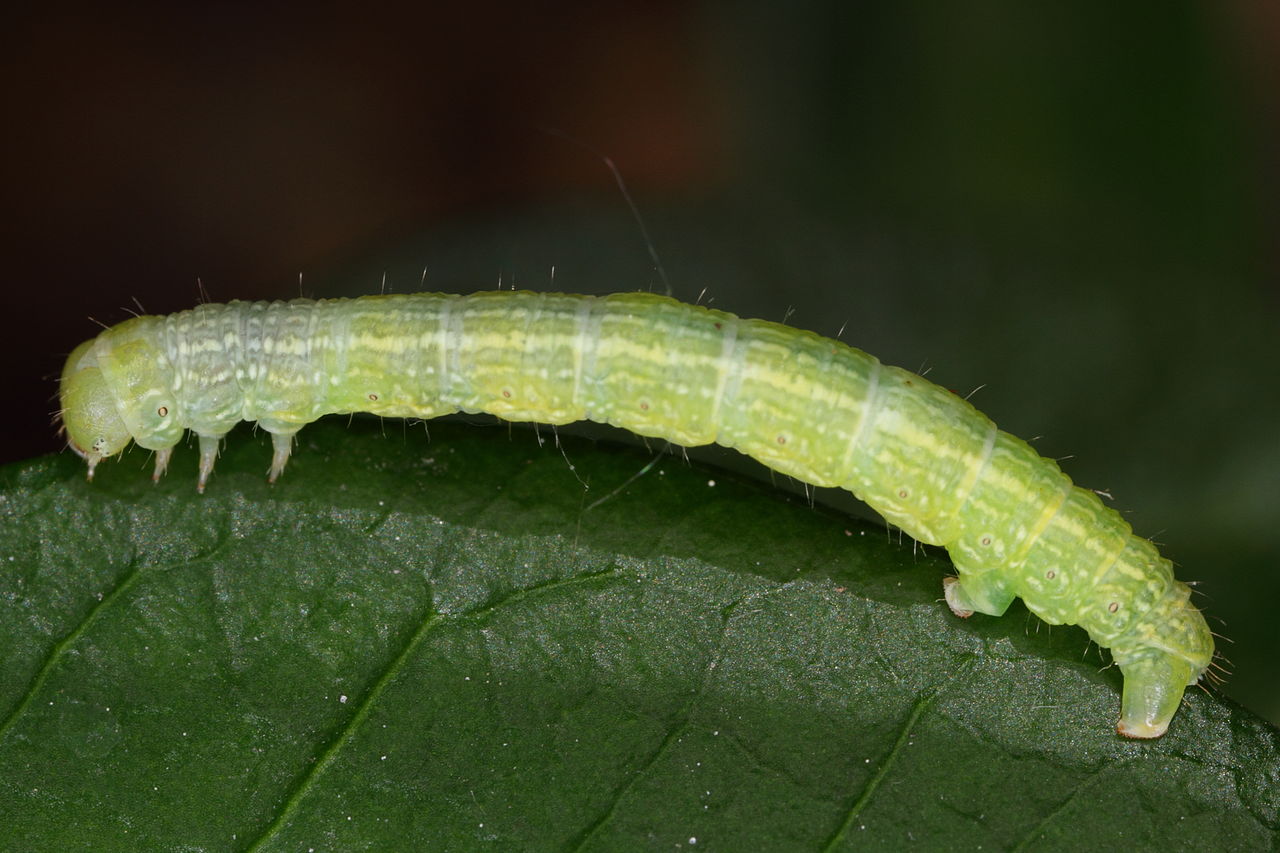
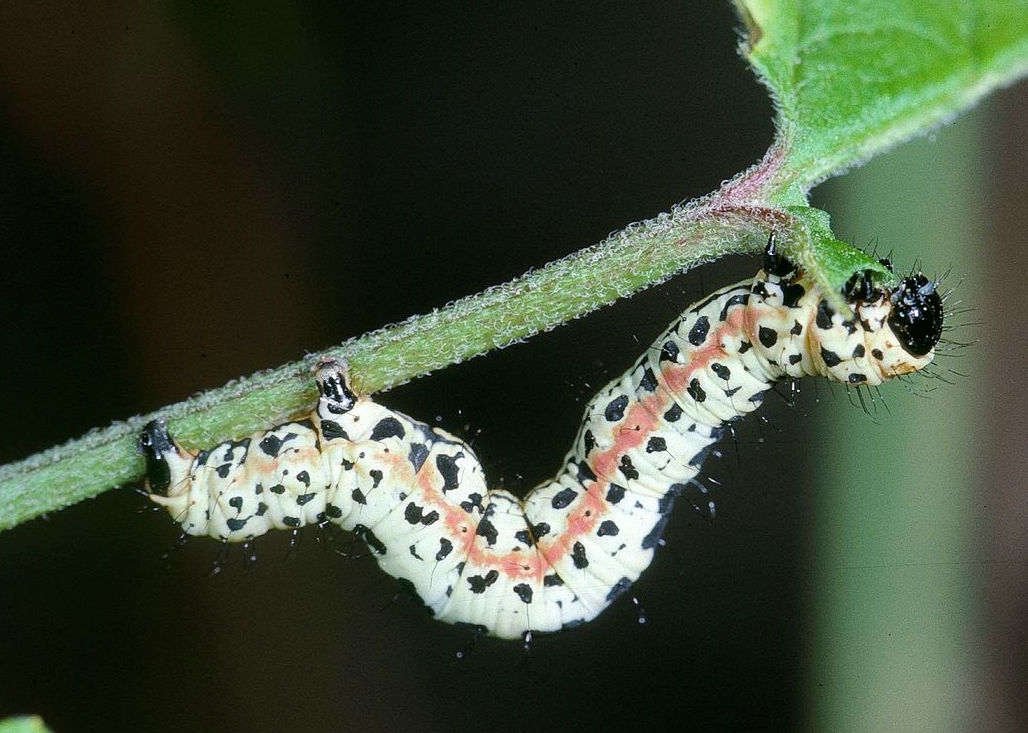
Left: Unidentified geometrid larva looking strikingly like a twig. Centre: winter moth larva Operophtera brumata - this is one often found dangling on a silk thread. Right: Magpie moth caterpillar Abraxas grossulariata larva, its conspicuous warning colouration is rare in geometrids, and it is one of the few toxic species.
Sphingidae - hawkmoths
Adult hawkmoths are large and splendid, and so are their solitary larvae. They are distinguished by having a "tail" at the end of their body, which may look like a sting, but is soft, harmless, and without an established purpose.
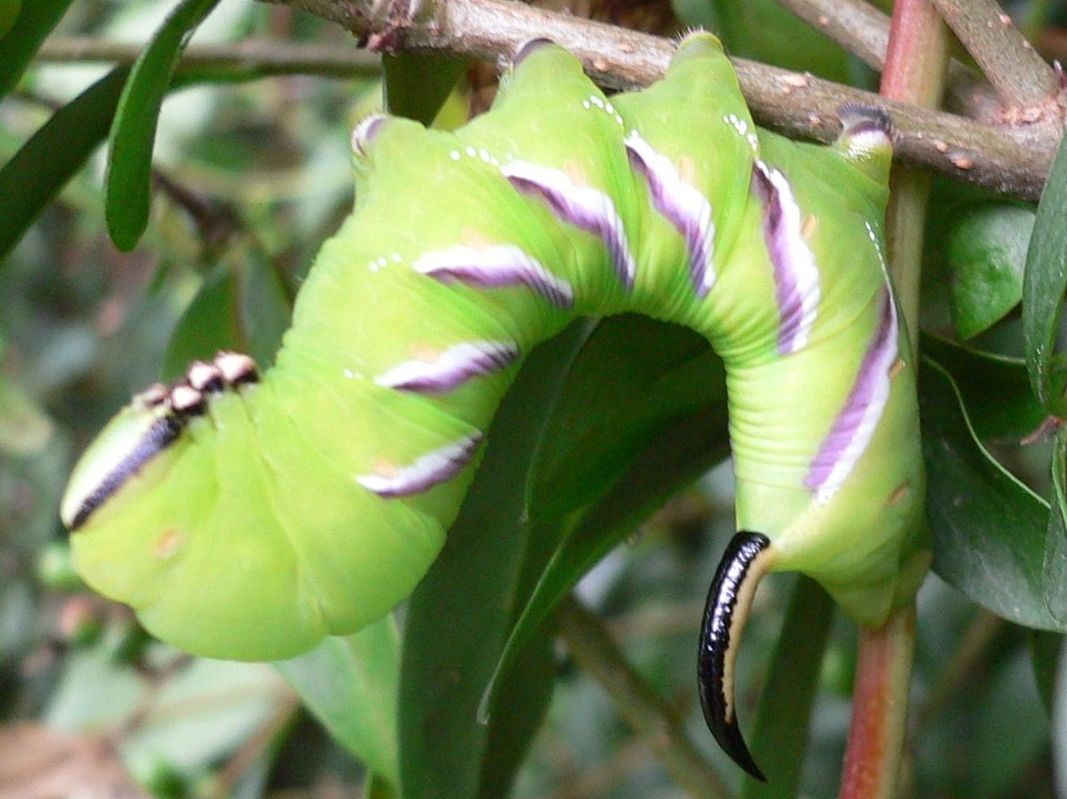
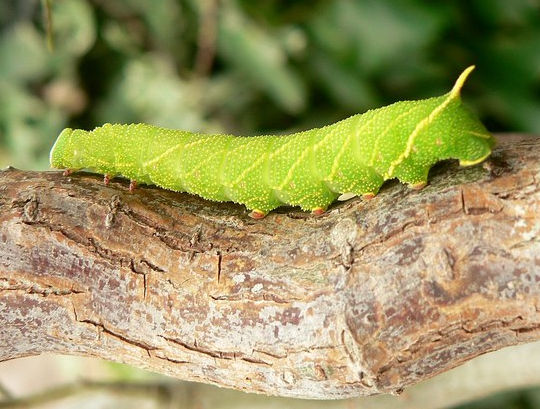
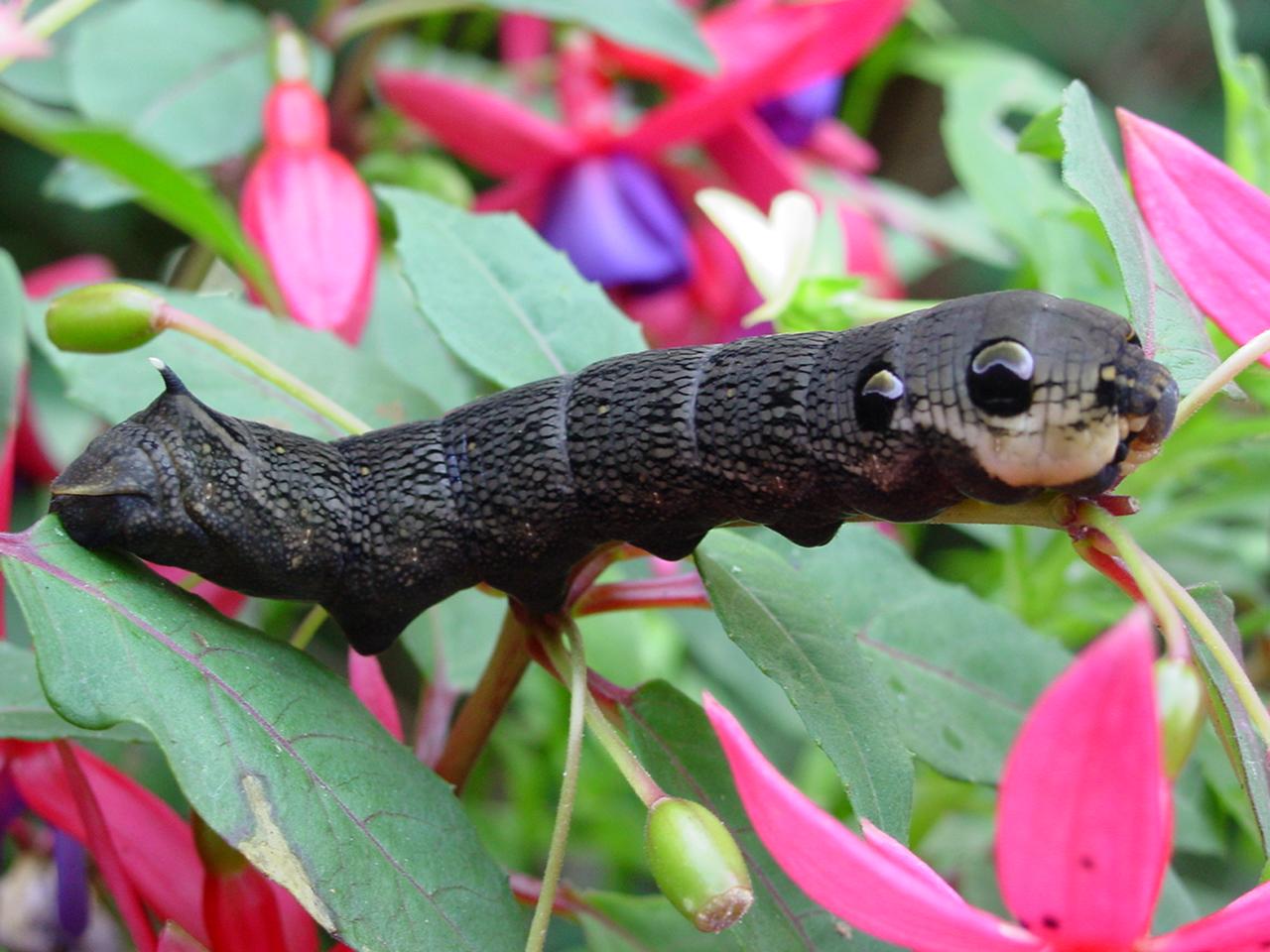
Left, larva of privet hawkmoth Sphinx ligustri Centre: Poplar hawkmoth - Laothoe populi Right: Elephant hawkmoth Deilephila elpenor. The elephant hawkmoth caterpillar feeds on willowherb and bedstraw - but is also very often found feeding on the exotic plant Fuchsia in the garden.
Notodontidae - Prominents
Larvae of prominents, such as the swallow prominent Pheosia tremula are substantial caterpilars, with large heads and often with "humps" on their backs. The puss moth Cerura vinula is named after the white furry adult moth, but its caterpillar is extremely distinctive, with two whip-like tails to deter predators, and a saddle mark which breaks up its outline. It also produced a unique cocoon strengthened with chewed wood fragments.
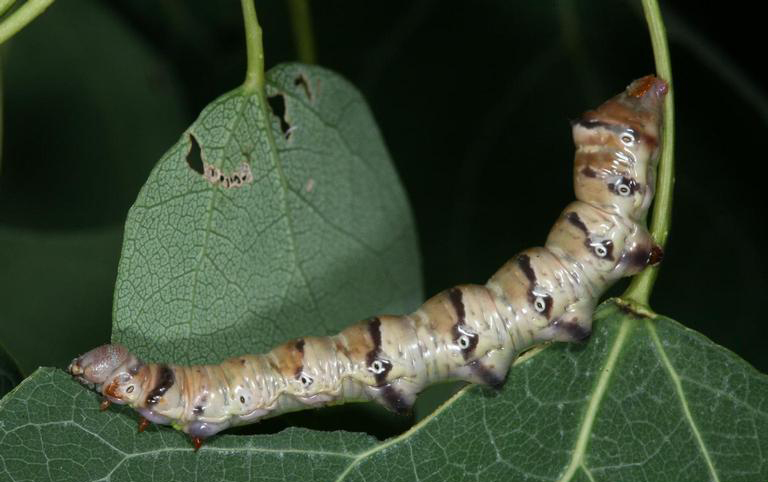
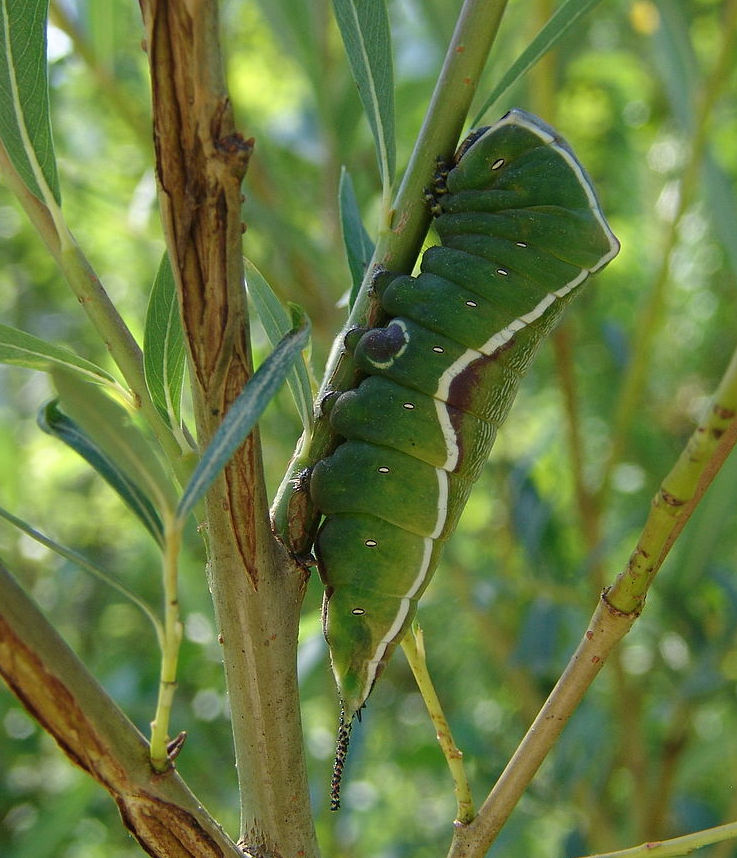
Swallow prominent Pheosia tremula larva Puss moth Cerura vinula
Erebidae
This large family of moths contains a great diversity of caterpillar types, many of which are hairy, spectacularly coloured and even armed with shaving brushes. Some gregarious hairy larvae, such as the brown-tail moth have unpleasantly irritating hairs, but most hairy caterpillars are completely harmless. It has been discovered that the function of long caterpillar hair is to deter beetle predators1. On the other hand, research has shown that hairy caterpillars are more vulnerable to attack by parasitoid insects2, probably because they are less cryptic than bare caterpillars.
.jpg)
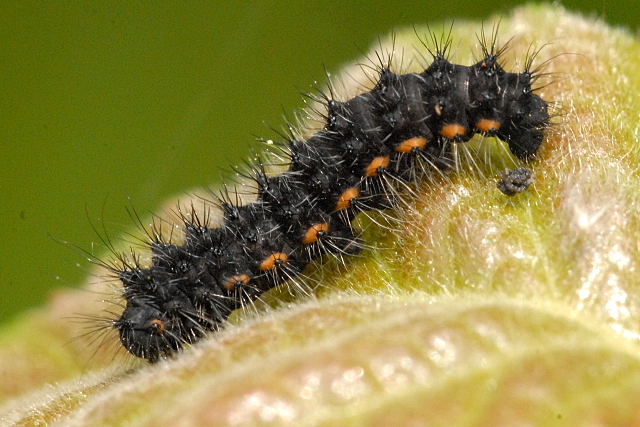
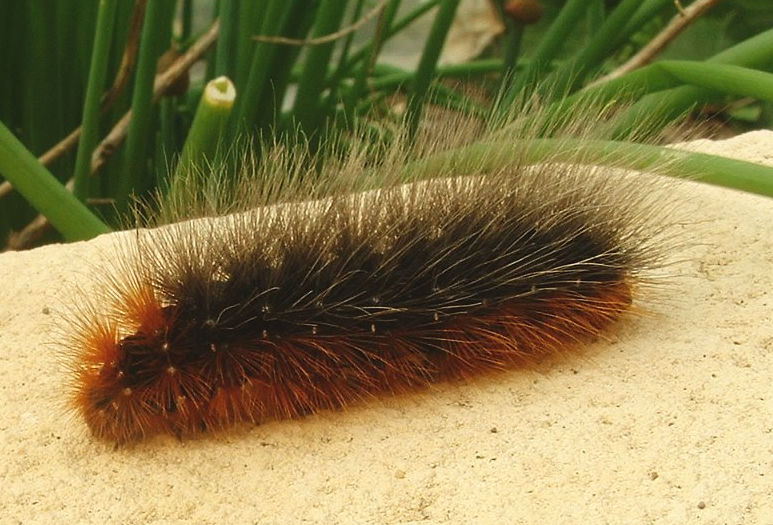
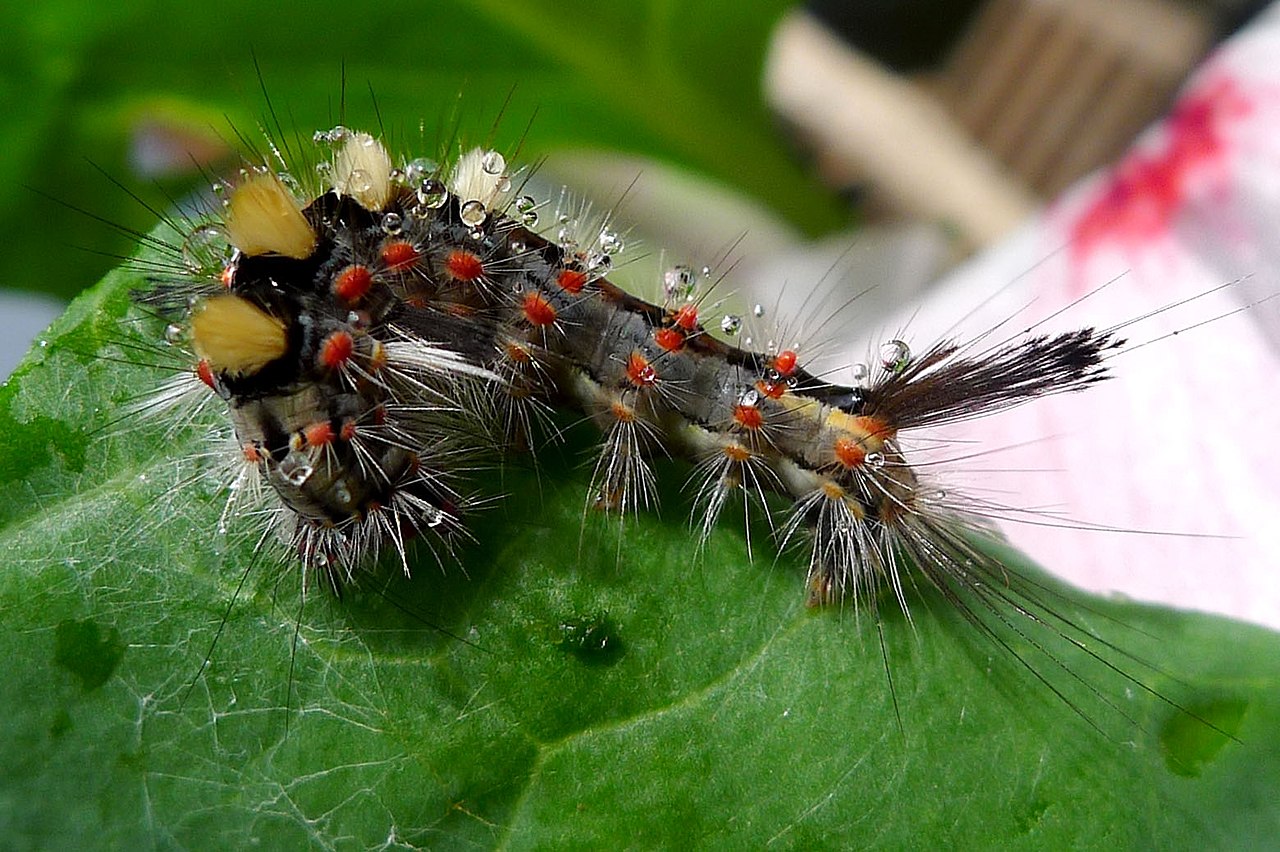
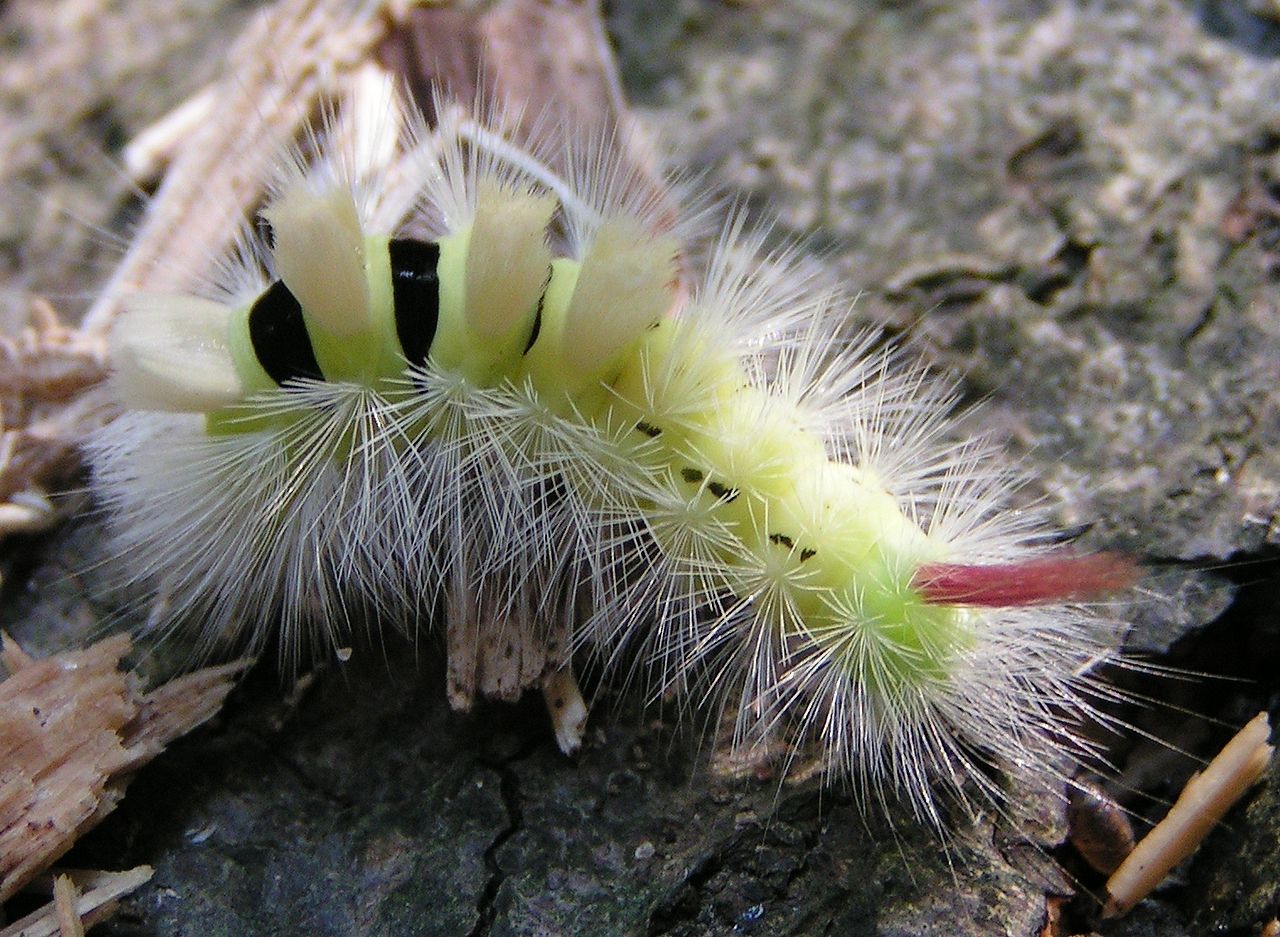
Vapourer moth Orgyia antiqua Pale tussock Calliteara pudibunda
Above left: garden tiger Arctia caja "woolly bear caterpillar"
Above right: yellow-tail Euproctis similis
Left: common footman Eilema lurideola,
Noctuid moths
Most noctuid caterpillars are relatively inconspicous and cryptic brown or green colour, some with short hairs. A few however are quite conspicuous.
.jpg)
_rups.jpg)
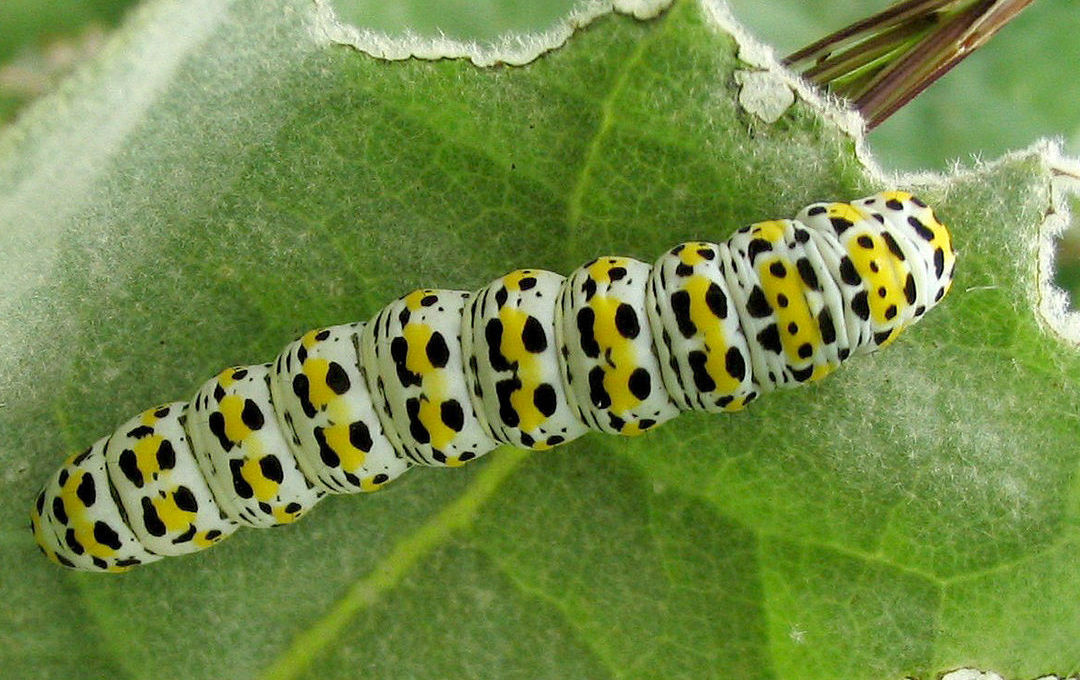
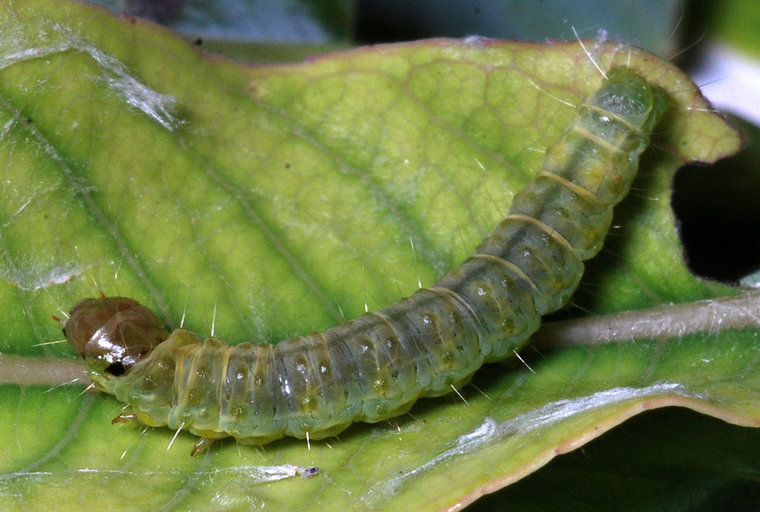
_(24-08-2006).jpg)
Typical noctuid larvae. Left: cabbage moth Mamestra brassicae Centre: Large yellow underwing Noctua pronuba Right: Tomato moth Lacanobia oleracea
Mullein moth Shargacucullia verbasci These moths can strip the foliage from Verbascum plants, and are visually conspicuous, advertising they taste disagreeable.
Micro moths
Some micro moth larvae are often seen in the garden. Jennifer Owen found the larvae of the white plume moth Pterophorus pentadactyla commonly on bindweeds Calystegia and Convolvulus. The codling moth Cydia pomonella commonly infests the fruit of apples. The carnation tortrix moth Cacoecimorpha pronubana is another nuisance
Moths with solitary larvae
Most moths lay their eggs in batches on suitable food plants for their caterpillar larvae, but after hatching, the larvae disperse and lead solitary lives. The relatively small number of species where the larvae stick together are covered in our page on moths with gregarious larvae.
The great majority of moth caterpillars do not live in groups, but are solitary, so in a sense this page covers nearly all moths. Some moth families have rather distinctive and easily spotted caterpillars, most are much less prominent and cryptic. We cover moths with leaf-mining caterpillars, stem-boring caterpillars, and root-feeding caterpillars on separate pages.
Geometridae
The family of geometrid moths derives its name from "earth-measurers", because the caterpillars also known as "inchworms" move relatively rapidly with a looping motion.
Geometrid caterpillars have unique features making them easy to identify. They have only two or three pairs of prolegs at the rear of their body, instead of the five pairs found in most lepidoptera, and the prolegs and true legs are separated by a long body - necessary for their looping locomotion. Many larvae are cryptically coloured, and when at rest they sometimes hold on with their prolegs and hold the long thin body out at an angle mimicking a twig. Another trick when threatened is to drop off the plant, remaining attached by a single silk thread spun from an organ below their mouth. Hanging in mid air, they are almost invulnerable to bird predators, and climb back up the thread when the panic is over.



Sphingidae - hawkmoths
Adult hawkmoths are large and splendid, and so are their solitary larvae. They are distinguished by having a "tail" at the end of their body, which may look like a sting, but is soft, harmless, and without an established purpose.
Above left: Unidentified geometrid larva looking strikingly like a twig. Above right: winter moth larva Operophtera brumata - this is one often found dangling on a silk thread.
Left: Magpie moth caterpillar Abraxas grossulariata larva, its conspicuous warning colouration is rare in geometrids, and it is one of the few toxic species.



Notodontidae - Prominents
Larvae of prominents, such as the swallow prominent Pheosia tremula are substantial caterpilars, with large heads and often with "humps" on their backs. The puss moth Cerura vinula is named after the white furry adult moth, but its caterpillar is extremely distinctive, with two whip-like tails to deter predators, and a saddle mark which breaks up its outline. It also produced a unique cocoon strengthened with chewed wood fragments.
Above left, larva of privet hawkmoth Sphinx ligustri Above right: Poplar hawkmoth - Laothoe populi
Left: Elephant hawkmoth Deilephila elpenor. The elephant hawkmoth caterpillar feeds on willowherb and bedstraw - but is also very often found feeding on the exotic plant Fuchsia in the garden.

Notodontidae - Prominents
Larvae of prominents, such as the swallow prominent Pheosia tremula are substantial caterpilars, with large heads and often with "humps" on their backs. The puss moth Cerura vinula is named after the white furry adult moth, but its caterpillar is extremely distinctive, with two whip-like tails to deter predators, and a saddle mark which breaks up its outline. It also produced a unique cocoon strengthened with chewed wood fragments.

Swallow prominent Pheosia tremula larva Puss moth Cerura vinula larva
Erebidae
This large family of moths contains a great diversity of caterpillar types, many of which are hairy, spectacularly coloured and even armed with shaving brushes. Some gregarious hairy larvae, such as the brown-tail moth have unpleasantly irritating hairs, but most hairy caterpillars are completely harmless. It has been discovered that the function of long caterpillar hair is to deter beetle predators1. On the other hand, research has shown that hairy caterpillars are more vulnerable to attack by parasitoid insects2, probably because they are less cryptic than bare caterpillars



.jpg)
Vapourer moth Orgyia antiqua Pale tussock Calliteara pudibunda
Above left: garden tiger Arctia caja "woolly bear caterpillar"
Above right: yellow-tail Euproctis similis
Left: common footman Eilema lurideola,

Noctuid moths
Most noctuid caterpillars are relatively inconspicous and cryptic brown or green colour, some with short hairs. A few however are quite conspicuous.
_(24-08-2006).jpg)
_rups.jpg)
.jpg)

Left: tomato moth Lacanobia oleracea Right: mullein moth Shargacucullia verbasci These moths can strip the foliage from Verbascum plants, and are visually conspicuous, advertising that they taste disagreeable.
Micro moths
Some micro moth larvae are often seen in the garden. Jennifer Owen found the larvae of the white plume moth Pterophorus pentadactyla commonly on bindweeds Calystegia and Convolvulus. The codling moth Cydia pomonella commonly infests the fruit of apples. The carnation tortrix moth Cacoecimorpha pronubana is another nuisance
Typical noctuid larvae. Left: cabbage moth Mamestra brassicae Right: Large yellow underwing Noctua pronuba

Left: white plume moth Pterophorus pentadactyla Right: carnation tortrix moth Cacoecimorpha pronubana
Role of moths with solitary larvae in gardens
Most moth larvae are inconspicuous and cause no significant damage to garden plants. Some moths have larvae that will attract attention to themselves because they can damage the foliage of garden plants. These include cabbage moth, Mamestra brassicae, on brassicas and other plants; winter moth, Operophtera brumata, on fruit trees and other deciduous trees; angleshades moth, Phlogophora meticulosa, on many plants; lesser yellow underwing, Noctua comes, on many low-growing plants; mullein moth, Shargacucullia verbasci, on verbascum species; carnation tortrix moth, Cacoecimorpha pronubana, on many garden and glasshouse plants; tomato moth, also known as bright-line brown-eye, Lacanobia oleracea, on tomato.
Moth larvae are an extremely important food source for many garden birds which collect them in huge numbers to feed their hatchlings.
References
1. Shinji Sugiura, Kazuo Yamazaki 2014 Caterpillar hair as a physical barrier against invertebrate predators, Behavioral Ecology, Volume 25, Pages 975–983, https://doi.org/10.1093/beheco/aru080
2. Stireman, J.O., and M.S. Singer. 2003. Determinants of parasitoid-host associations: insights from a natural tachinid-lepidopteran community. Ecology 84(2): 296-310.
Books
James, D.G. (2017) The Book of Caterpillars. Ivy Press (Not for identification use! International in scope, but a fascinating and well illustrated compendium of caterpillar diversity)
Porter, J. (2010) Colour Identification Guide to the Caterpillars of the British Isles. Apollo Books
Sterling, P., Henwood, B., Lewington, R. (2020) Field Guide to the Caterpillars of Great Britain and Ireland
Bloomsbury Wildlife Guides
Websites
Website of UK Moths
Page drafted by Andrew Halstead, reviewed by Andrew Salisbury, edited by Steve Head
.jpg)
.jpg)












